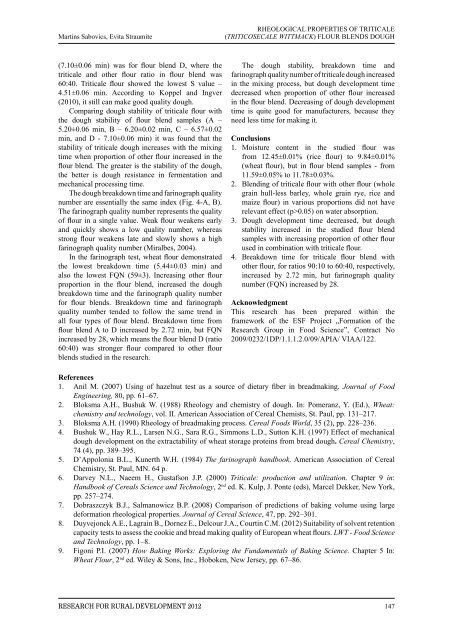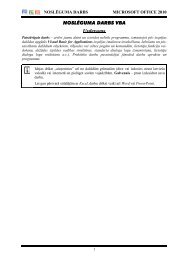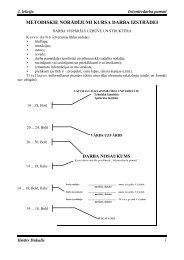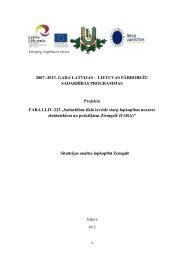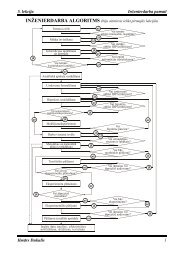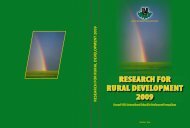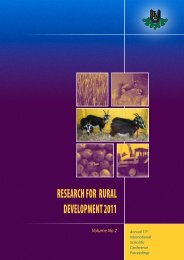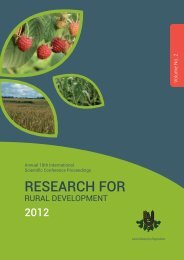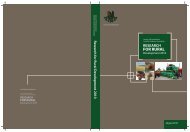LATVIA UNIVERSITY OF AGRICULTURE - Latvijas ...
LATVIA UNIVERSITY OF AGRICULTURE - Latvijas ...
LATVIA UNIVERSITY OF AGRICULTURE - Latvijas ...
- No tags were found...
You also want an ePaper? Increase the reach of your titles
YUMPU automatically turns print PDFs into web optimized ePapers that Google loves.
Martins Sabovics, Evita StraumiteRHEOLOGICAL PROPERTIES <strong>OF</strong> TRITICALE(TRITICOSECALE WITTMACK) FLOUR BLENDS DOUGH(7.10±0.06 min) was for flour blend D, where thetriticale and other flour ratio in flour blend was60:40. Triticale flour showed the lowest S value –4.51±0.06 min. According to Koppel and Ingver(2010), it still can make good quality dough.Comparing dough stability of triticale flour withthe dough stability of flour blend samples (A –5.20±0.06 min, B – 6.20±0.02 min, C – 6.57±0.02min, and D - 7.10±0.06 min) it was found that thestability of triticale dough increases with the mixingtime when proportion of other flour increased in theflour blend. The greater is the stability of the dough,the better is dough resistance in fermentation andmechanical processing time.The dough breakdown time and farinograph qualitynumber are essentially the same index (Fig. 4-A, B).The farinograph quality number represents the qualityof flour in a single value. Weak flour weakens earlyand quickly shows a low quality number, whereasstrong flour weakens late and slowly shows a highfarinograph quality number (Miralbes, 2004).In the farinograph test, wheat flour demonstratedthe lowest breakdown time (5.44±0.03 min) andalso the lowest FQN (59±3). Increasing other flourproportion in the flour blend, increased the doughbreakdown time and the farinograph quality numberfor flour blends. Breakdown time and farinographquality number tended to follow the same trend inall four types of flour blend. Breakdown time fromflour blend A to D increased by 2.72 min, but FQNincreased by 28, which means the flour blend D (ratio60:40) was stronger flour compared to other flourblends studied in the research.The dough stability, breakdown time andfarinograph quality number of triticale dough increasedin the mixing process, but dough development timedecreased when proportion of other flour increasedin the flour blend. Decreasing of dough developmenttime is quite good for manufacturers, because theyneed less time for making it.Conclusions1. Moisture content in the studied flour wasfrom 12.45±0.01% (rice flour) to 9.84±0.01%(wheat flour), but in flour blend samples - from11.59±0.05% to 11.78±0.03%.2. Blending of triticale flour with other flour (wholegrain hull-less barley, whole grain rye, rice andmaize flour) in various proportions did not haverelevant effect (p>0.05) on water absorption.3. Dough development time decreased, but doughstability increased in the studied flour blendsamples with increasing proportion of other flourused in combination with triticale flour.4. Breakdown time for triticale flour blend withother flour, for ratios 90:10 to 60:40, respectively,increased by 2.72 min, but farinograph qualitynumber (FQN) increased by 28.AcknowledgmentThis research has been prepared within theframework of the ESF Project „Formation of theResearch Group in Food Science”, Contract No2009/0232/1DP/1.1.1.2.0/09/APIA/ VIAA/122.References1. Anil M. (2007) Using of hazelnut test as a source of dietary fiber in breadmaking. Journal of FoodEngineering, 80, pp. 61–67.2. Bloksma A.H., Bushuk W. (1988) Rheology and chemistry of dough. In: Pomeranz, Y. (Ed.), Wheat:chemistry and technology, vol. II. American Association of Cereal Chemists, St. Paul, pp. 131–217.3. Bloksma A.H. (1990) Rheology of breadmaking process. Cereal Foods World, 35 (2), pp. 228–236.4. Bushuk W., Hay R.L., Larsen N.G., Sara R.G., Simmons L.D., Sutton K.H. (1997) Effect of mechanicaldough development on the extractability of wheat storage proteins from bread dough. Cereal Chemistry,74 (4), pp. 389–395.5. D’Appolonia B.L., Kunerth W.H. (1984) The farinograph handbook. American Association of CerealChemistry, St. Paul, MN. 64 p.6. Darvey N.L., Naeem H., Gustafson J.P. (2000) Triticale: production and utilization. Chapter 9 in:Handbook of Cereals Science and Technology, 2 nd ed. K. Kulp, J. Ponte (eds), Marcel Dekker, New York,pp. 257–274.7. Dobraszczyk B.J., Salmanowicz B.P. (2008) Comparison of predictions of baking volume using largedeformation rheological properties. Journal of Cereal Science, 47, pp. 292–301.8. Duyvejonck A.E., Lagrain B., Dornez E., Delcour J.A., Courtin C.M. (2012) Suitability of solvent retentioncapacity tests to assess the cookie and bread making quality of European wheat flours. LWT - Food Scienceand Technology, pp. 1–8.9. Figoni P.I. (2007) How Baking Works: Exploring the Fundamentals of Baking Science. Chapter 5 In:Wheat Flour, 2 nd ed. Wiley & Sons, Inc., Hoboken, New Jersey, pp. 67–86.Research for Rural Development 2012147


